Huntsville, Alabama 作者: 来源: 发布时间:2021-07-19
I.Population and Area
₋Area
Land:
City: sq mi (566.95 km2)
Land: 7.53 sq mi (563.39 km2)
Water: 38 sq mi (3.56 km2)
₋Population
City:180,105
Estimate :200,574
Density: 922.07/sq mi (356.01/km2)
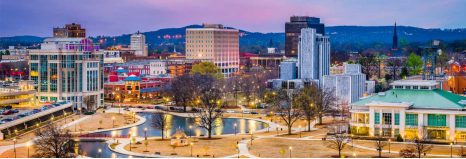
II.Natural Geography
₋Huntsville is a city in the Appalachian region of northern Alabama. It is the county seat of Madison County but extends west into neighboring Limestone County and south into Morgan County.
₋It was founded in 1805 and became an incorporated town in 1811. The city grew across nearby hills north of the Tennessee River, adding textile mills, then munitions factories, NASA's Marshall Space Flight Center and the United States Army Aviation and Missile Command nearby at the Redstone Arsenal. The National Trust for Historic Preservation named Huntsville to its "America's Dozen Distinctive Destinations for 2010" list.
₋The city's population was 180,105 in 2010, making it Alabama's fourth-largest city. Huntsville is the largest city in the five-county Huntsville-Decatur-Albertville, AL Combined Statistical Area. The Huntsville metropolitan area's population was 417,593 in 2010, making it the second most populous metropolitan area in the state. The Huntsville metro's population reached 462,693 by 2018.
₋Huntsville is located at 34°42′N 86°35′W (34.7, -86.6). The city has a total area of 210.0 square miles (543.9 km2). Huntsville has grown through recent annexations west into Limestone County, a total of 21.5 square miles (56 km2), or 13,885 acres (5,619 ha).
₋Situated in the Tennessee River valley, Huntsville is partially surrounded by several plateaus and large hills. These plateaus are associated with the Cumberland Plateau, and are locally called "mountains". Monte Sano Mountain (Spanish for "Mountain of Health") is the most notable, and is east of the city along with Round Top (Burritt), Chapman, Huntsville, and Green mountains. Others are Wade Mountain to the north, Rainbow Mountain to the west, and Weeden and Madkin mountains on the Redstone Arsenal property in the south. Brindley Mountain is visible in the south across the Tennessee River.
₋As with other areas along the Cumberland Plateau, the land \around Huntsville is karst in nature. The city was founded around the Big Spring, which is a typical karst spring. Many caves perforate the limestone bedrock underneath the surface, as is common in karst areas. The National Speleological Society is headquartered in Huntsville.
₋Transportation
₋Huntsville is served by several U.S. Highways, including 72, 231, 431 and an Interstate highway spur, I-565, that links Huntsville and Decatur to I-65. Alabama Highway 53 also connects the city with I-65 in Ardmore, Tennessee. Major roadways include University Drive, Governors Drive, Airport Road, Memorial Parkway and Research Park Blvd.
₋Cited as "Restore Our Roads", the city of Huntsville, between 2014 and 2019, will perform about $383 million worth of road construction to improve the transportation infrastructure. Some of the funds for the road work comes from an increase in sales tax, while others come from various sources including the Alabama Transportation Rehabilitation and Improvement Program. Major road projects include:
Memorial Parkway overpasses at Martin Road, Lily Flagg, and Mastin Lake Road
Widening US 72 over Chapman Mountain
Widening US 72 from Providence Main Street to County Line Road from 4 lanes to 6 lanes
Access and intersection improvements along Memorial Parkway
Extending the Northern Bypass from Pulaski Pike to US-231/431
Widening Cecil Ashburn Drive over Huntsville Mountain from 2 to 4 lanes
₋Additional road projects include reconstructing Holmes Avenue over Pinhook Creek, widening Zierdt, Martin and Winchester Roads, widening Old Madison Pike from Cummings Research Park to the city of Madison, relocating and widening Church Street north of Downtown, relocating Wynn Drive to allow an extension of the Calhoun Community College campus, various improvements along US 431 north of Hampton Cove, creating a new Downtown Gateway with the extension of Harvard Road from Governors Drive to Williams Avenue for a direct connection to Downtown, and extending Weatherly Road to the new Grissom High School.
₋In 2015, Alabama and Huntsville were not considered bicycle friendly. There are bike paths for exercise available. Huntsville government is working to improve bicycle network within the city limits.
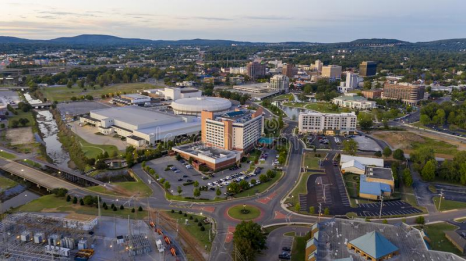
III.GDP
₋The average salary in Huntsville, AL is $70k. Trends in wages increased by 1.0 percent in Q1 2020. The cost of living in Huntsville, AL is 5 percent higher than the national average. The most popular occupations in Huntsville, AL are Software Engineer, Mechanical Engineer, and Aerospace Engineer which pay between $39k and $124k per year. The most popular employers in Huntsville, AL are Dynetics, Inc., Science Applications International Corporation (SAIC), and Northrop Grumman Corporation.
₋Website: https://www.payscale.com/research/US/Location=Huntsville-AL/Salary
IV.Industrial Characteristics
₋Huntsville's main economic influence is derived from aerospace and military technology. Redstone Arsenal, Cummings Research Park (CRP), and NASA's Marshall Space Flight Center comprise the main hubs for the area's technology-driven economy. CRP is the second largest research park in the United States and the fourth largest in the world. University of Alabama in Huntsville is a center for technology and engineering research in the area. There are commercial technology companies such as the network access company ADTRAN, computer graphics company Intergraph and designer and manufacturer of IT infrastructure Avocent. Cinram manufactures and distributes 20th Century Fox DVDs and Blu-ray Discs out of their Huntsville plant. Sanmina-SCI has a presence in the area. Fifty-seven Fortune 500 companies have operations in Huntsville.
₋In 2005, Forbes magazine named the Huntsville-Decatur Combined Statistical Area as 6th best in the nation for doing business, and number one in terms of the number of engineers per total employment. In 2006, Huntsville dropped to 14th; the prevalence of engineers was not considered in the 2006 ranking.
₋Retail
₋There are several strip malls and shopping malls throughout the city. Huntsville has one enclosed mall, Parkway Place, built in 2002 on the site of the former Parkway City Mall. A larger mall built in 1984, Madison Square Mall, was closed in 2017 and the site is to be redeveloped into a lifestyle center, now known as Mid City. There is also a lifestyle center named Bridge Street Town Centre, completed in 2007, in Cummings Research Park.
₋Space and defense
₋Huntsville remains the center for rocket-propulsion research in NASA and the Army. The Marshall Space Flight Center has been designated to develop NASA's future Space Launch System (SLS), and the U.S. Army Aviation and Missile Command (AMCOM) is responsible for developing a variety of rocket-based tactical weapons.
₋Automobiles
₋Toyota Motor Manufacturing Alabama, located in North Huntsville Industrial Park and separate from the under-construction Mazda Toyota Manufacturing USA facility, has 1,350 employees as of 2019. The plant has plans to expand, and to employ 1,800 individuals by 2021 (https://www.al.com/news/2019/03/toyota-adds-450-new-jobs-at-huntsville-motor-plant.html). The plant manufactures engines for Toyota vehicles.
₋The planned Mazda Toyota Manufacturing USA facility plans to open by 2021 with up to 4,000 employees (https://www.waff.com/2019/10/14/huntsvilles-mazda-toyota-manufacturing-plant-construction-update). The new plant plans to become an assembly facility where SUV's are made for both Mazda and Toyota.
V.Attractions
1.U.S. Space & Rocket Center
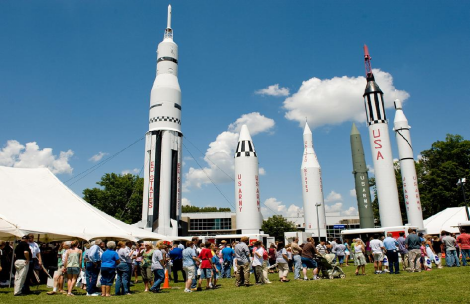
₋The U.S. Space & Rocket Center in Huntsville, Alabama is a museum operated by the government of Alabama, showcasing rockets, achievements, and artifacts of the U.S. space program. Sometimes billed as "Earth's largest space museum", astronaut Owen Garriott described the place as, "a great way to learn about space in a town that has embraced the space program from the very beginning."
₋The center opened in 1970, just after the Apollo 12 Moon landing, the second crewed mission to the lunar surface. It showcases Apollo Program hardware and also houses interactive science exhibits, Space Shuttle exhibits, and Army rocketry and aircraft. With more than 1,500 permanent rocketry and space exploration artifacts, as well as many rotating rocketry and space-related exhibits, the center occupies land carved out of Redstone Arsenal adjacent to Huntsville Botanical Garden at exit 15 on Interstate 565. The center offers bus tours of nearby NASA's Marshall Space Flight Center.
₋Two camp programs offer visitors the opportunity to stay on the grounds to learn more about spaceflight and aviation. U.S. Space Camp gives an in-depth exposure to the space program through participant use of simulators, lectures, and training exercises. Aviation Challenge offers a taste of military fighter pilot training, including simulations, lectures, and survival exercises. Both camps provide residential and day camp educational programs for children and adults.
₋Address: 1 Tranquility Base, Huntsville, AL 35805, United States
₋Phone: +1 800-637-7223
₋Website: https://www.rocketcenter.com/
2.Huntsville Botanical Garden
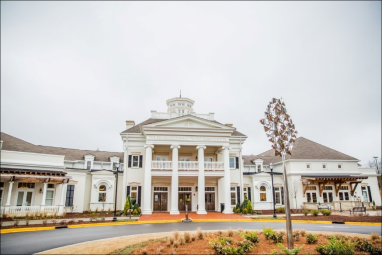
₋The Huntsville Botanical Garden is a 112 acres (453,000 m²) botanical garden located at 4747 Bob Wallace Avenue, Huntsville, Alabama, near the U.S. Space & Rocket Center. It is open year-round for a fee. The garden is fifth on the list of Alabama's top paid tourist attractions, receiving 307,985 visitors in 2008.
₋The gardens include a seasonal butterfly house, and aquatic, annual, daylily, fern, herb, perennial, rose, and wildflower gardens, as well as a nature path and collection of Flowering Dogwood trees. Specific sections of the garden are as follows:
Nature center - overlooks Little Smith Lake, houses the open-aired butterfly house, open May through September
Biblical garden, featuring plants mentioned in the Bible
Central Corridor - with perennial garden, aquatic garden, and bulb and annual garden.
Daylily Garden - over 675 cultivars of daylilies.
Dogwood Trail - numerous Flowering Dogwood (Cornus florida) trees, including a hundred year old dogwood transplanted to the site, along a forest path.
Fern Glade - almost 150 species of ferns, including Christmas Fern (Polystichum acrostichoides), Northern Maidenhair Fern (Adiantum pedatum), Southern Maidenhair Fern (Adiantum capillus-veneris), Sensitive Fern (Onoclea sensibilis), Royal Fern (Osmunda spectabilis), and Cinnamon Fern (Osmundastrum cinnamomeum).
Herb Garden - 14 theme gardens and a cottage.
Nature Trail - paths through an indigenous southeastern lowland forest, with Black Tupelo (Nyssa sylvatica), Red Maple (Acer rubrum), Sycamore (Platanus occidentalis), and Sweetgum (Liquidambar styraciflua) trees, and undergrowth including Sweet William (Phlox divaricata), Wild Columbine (Aquilegia canadensis), Foamflower (Tiarella cordifolia), Scarlet Sage (Salvia coccinea), Bellflower (Campanula americana), and Black-eyed Susan (Rudbeckia hirta).
Vegetable Garden - four model gardens for the home gardener.
₋Address: 4747 Bob Wallace Ave SW, Huntsville, AL 35805, United States
₋Phone: +1 256-830-4447
₋Website: https://hsvbg.org/
3.Monte Sano State Park
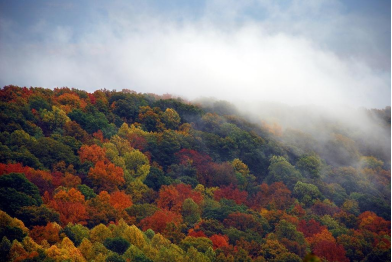
₋Monte Sano State Park is a publicly owned recreation area and mountaintop retreat encompassing 2,140 acres (870 ha) on the eastern portion of the top and slopes of Monte Sano Mountain on the east side of Huntsville, Alabama. The state park has 1930s-era, Civilian Conservation Corps–built rustic cottages, hiking trails and picnic areas with scenic overlooks, and modern campsites. It is managed by the Alabama Department of Conservation and Natural Resources.
₋The name "Monte Sano" derives from the Spanish for "mountain of health" and is the eponymous name of the mountain that is the main feature of the park. The name reflects the 19th-century tradition of sending diphtheria, cholera and yellow fever sufferers to retreats on the mountain. A week's stay at the Hotel Monte Sano, a three-story Queen Anne–style luxury health resort with 233 rooms that opened in 1877, cost $11 and included amusements like bowling, horseback riding, croquet and lawn tennis. A railway line built to carry patients up the mountain ran from 1888 to 1896 before going bankrupt. Remnants of the line may be seen in the adjoining Monte Sano Nature Preserve operated by the Land Trust of North Alabama. The development of vaccines and treatments ended the era of health trips to the mountain.
₋Workers with the Civilian Conservation Corps developed the park in the 1930s, constructing an amphitheater, lodge, and rustic cottages built in the Arts and Crafts style. The park officially opened on August 25, 1938. It was added to the Alabama Register of Landmarks and Heritage in 1996.
₋Address: 5105 Nolen Ave SE, Huntsville, AL 35801, United States
₋Website: http://www.alapark.com/parks/monte-sano-state-park
VI.History
₋First settlers
₋The first settlers of the area were Muscogee-speaking people. The Chickasaw traditionally claim to have settled around 1300 after coming east across the Mississippi. A combination of factors, including disease, land disputes between the Choctaw and Cherokee, and pressures from the United States government had largely depopulated the area by the time Revolutionary War veteran John Hunt settled in the land around the Big Spring in 1805. The 1805 Treaty with the Chickasaws and the Cherokee Treaty of Washington of 1806 ceded native claims to the United States government. The area was subsequently purchased by LeRoy Pope, who named the area Twickenham after the home village of his distant kinsman Alexander Pope.
₋Twickenham was carefully planned, with streets laid out on the northeast to southwest direction based on the flow of Big Spring. However, due to anti-British sentiment during this period, the name was changed to "Huntsville" to honor John Hunt, who had been forced to move to other land south of the new city.
₋Both John Hunt and LeRoy Pope were Freemasons and charter members of Helion Lodge #1, the oldest Lodge in Alabama.
₋Incorporation
₋In 1811, Huntsville became the first incorporated town in Alabama. However, the recognized "founding" year of the city is 1805, the year of John Hunt's arrival. The city celebrated its sesquicentennial in 1955 and its bicentennial in 2005.
₋David Wade arrived in Huntsville in 1817. He built the David Wade House on the north side of what is now Bob Wade Lane (Robert B. Wade was David's grandson) just east of Mt. Lebanon Road. It had six rough Doric columns on the portico.
₋During the Great Depression, the Wade House was measured as part of the Historic American Buildings Survey (HABS) to be included in the government's Archive and was photographed by Frances Benjamin Johnston for the project. This project put architects, draftsmen, and photographers to work to create an inventory of documentation and photographs of significant properties across the country. The house had already been abandoned for years and was considerably deteriorated. It was torn down in 1952. Today only the antebellum smokehouse, an imposing structure itself, survives at the property.
₋Emerging industries
₋Huntsville's quick growth was from wealth generated by the cotton and railroad industries. Many wealthy planters moved into the area from Virginia, Georgia, and the Carolinas.[citation needed] In 1819, Huntsville hosted a constitutional convention in Walker Allen's large cabinetmaking shop. The 44 delegates meeting there wrote a constitution for the new state of Alabama. In accordance with the new state constitution, Huntsville became Alabama's first capital when the state was admitted to the Union. This was a temporary designation for one legislative session only. The capital was moved to more central cities; to Cahawba, then to Tuscaloosa, and finally to Montgomery.
₋In 1855, the Memphis and Charleston Railroad was constructed through Huntsville, becoming the first railway to link the Atlantic seacoast with the lower Mississippi River.
₋Civil War
₋Huntsville initially opposed secession from the Union in 1861, but provided many men for the Confederacy's efforts. The 4th Alabama Infantry Regiment, led by Col. Egbert J. Jones of Huntsville, distinguished itself at the Battle of Manassas/Bull Run, the first major encounter of the American Civil War. The Fourth Alabama Infantry, which contained two Huntsville companies, were the first Alabama troops to fight in the war and were present when Lee surrendered to Grant at Appomattox Court House in April 1865. Nine generals of the war were born in or near Huntsville, split five to the Confederate and four to the Union.
₋On the morning of April 11, 1862, Union troops led by General Ormsby M. Mitchel seized Huntsville in order to sever the Confederacy's rail communications and gain access to the Memphis & Charleston Railroad. Huntsville was the control point for the Western Division of the Memphis & Charleston, and by controlling this railroad the Union had struck a major blow to the Confederacy.
₋During the first occupation, Union officers occupied many of the larger homes in the city while the enlisted soldiers camped mainly on the outskirts. In the initial occupation, the Union troops searched for both Confederate troops hiding in the town and weapons. Since they occupied the city, treatment toward Huntsville was relatively civil. However, residents of the nearby towns did not fare as well.
₋The Union troops were forced to retreat only a few months later, but they returned to Huntsville in the fall of 1863 and thereafter used the city as a base of operations for the war, except during the last months of 1864. While many homes and villages in the surrounding countryside were burned in retaliation for the active guerrilla warfare in the area, Huntsville itself survived because it housed Union Army troops.
₋After the Civil War
₋After the Civil War, Huntsville became a center for cotton textile mills, such as Lincoln, Dallas, and Merrimack. Each mill company constructed worker housing, in communities that included schools, churches, grocery stores, theaters, and hardware stores, all within walking distance of the mill. In some of these, workers were required to buy goods at the company stores, which sometimes overcharged them. The mill owners could throw out workers from housing if they violated policies about behavior.
₋A dairy cow called Lily Flagg broke the world record for butter production in 1892. Her Huntsville-resident owner General Samuel H. Moore painted his house butter yellow and organized a party to celebrate, arranging for electric lights for the dance floor. An area south of Huntsville was named Lily Flagg before 1906. This area was later annexed by the city.
₋Great Depression 1930s
₋During the 1930s, industry declined in Huntsville due to the Great Depression. Huntsville became known as the Watercress Capital of the World[36] because of its abundant harvest in the area. Madison County led Alabama in cotton production during this time.
₋World War II
₋By 1940, Huntsville was still relatively small, with a population of about 13,000 inhabitants. This quickly changed in early 1941 when the U.S. Army selected 35,000 acres (140 km2) of land adjoining the southwest area of the city for building three chemical munitions facilities: the Huntsville Arsenal, the Redstone Ordnance Plant (soon redesignated Redstone Arsenal), and the Gulf Chemical Warfare Depot. These operated throughout World War II, with combined personnel approaching 20,000. Resources in the area were strained as new workers flocked to the area, and the construction of housing could not keep up.
₋Missile development
₋At the end of the war in 1945, the munitions facilities were no longer needed. They were combined with the designation Redstone Arsenal (RSA), and a considerable political and business effort was made in attempts to attract new tenants. One significant start involved manufacturing the Keller automobile, but this closed after 18 vehicles were built. With the encouragement of US Senator John Sparkman, the U.S. Army Air Force considered this for a major testing facility, but then selected another site. Redstone Arsenal was prepared for disposal, but Sparkman used his considerable Southern Democratic influence (the Solid South controlled numerous powerful chairmanships of congressional committees) to persuade the Army to choose it as a site for rocket and missile development.
₋In 1950, about 1,000 personnel were transferred from Fort Bliss, Texas, to Redstone Arsenal to form the Ordnance Guided Missile Center (OGMC). Central to this was a group of about 200 Nazi scientists and engineers from Germany, led by Wernher von Braun; they had been brought to America by Colonel Holger Toftoy under Operation Paperclip following World War II. Assigned to the center at Huntsville, they settled and reared families in this area.
₋As the Korean War started, the OGMC was given the mission to develop what eventually became the Redstone Rocket. This rocket set the stage for the United States' space program, as well as major Army missile programs, to be centered in Huntsville. Toftoy, then a brigadier general, commanded OGMC and the overall Redstone Arsenal. In early 1956, the Army Ballistic Missile Agency (ABMA) under Major General John Medaris was formed.
₋Early American space flight
₋The city is nicknamed "The Rocket City" for its close association with U.S. space missions. On January 31, 1958, ABMA placed America's first satellite, Explorer 1, into orbit using a Jupiter-C launch vehicle, a descendant of the Redstone. This brought national attention to Redstone Arsenal and Huntsville, with widespread recognition of this being a major center for high technology.[citation needed]
₋On July 1, 1960, 4,670 civilian employees, associated buildings and equipment, and 1,840 acres (7.4 km2) of land, transferred from ABMA to form NASA's George C. Marshall Space Flight Center (MSFC). Wernher von Braun was MSFC's initial director. On September 8, President Dwight D. Eisenhower formally dedicated the MSFC.
₋During the 1960s, the major mission of MSFC was in developing the Saturn boosters used by NASA in the Apollo Lunar Landing Program. For this, MSFC greatly increased its employees, and many new companies joined the Huntsville industrial community. The Cummings Research Park was developed just north of Redstone Arsenal to partially accommodate this industrial growth, and has now became the second-largest research park of this type in America.
₋Huntsville's economy was nearly crippled and growth almost came to a standstill in the 1970s following the closure of the Apollo program. However, the emergence of the Space Shuttle, the International Space Station, and a wide variety of advanced research in space sciences led to a resurgence in NASA-related activities that has continued into the 21st century. In addition, new Army organizations have emerged at Redstone Arsenal, particularly in the ever-expanding field of missile defense.
₋Now in the 2000s, Huntsville has the second-largest technology and research park in the nation, and ranks among the top 25 most educated cities in the nation. It is considered in the top of the nation's high-tech hotspots, and one of the best Southern cities for defense jobs. It is the number one United States location for engineers most satisfied with the recognition they receive, with high average salary and low median gross rent.
₋Biotechnology
₋More than 25 biotechnology firms have developed in Huntsville due to the Huntsville Biotech Initiative. The HudsonAlpha Institute for Biotechnology is the centerpiece of the 150-acre Cummings Research Park Biotech Campus, part of the 4,000-acre Cummings Research Park, which is second only to North Carolina's Research Triangle Park in land area. The non-profit HudsonAlpha Institute has contributed genomics and genetics work to the Encyclopedia of DNA Elements (ENCODE). For-profit business ventures within the Biotech Campus focus on subjects such as infectious disease diagnostics, immune responses to disease and cancer, protein crystallization, lab-on-a-chip technologies, and improved agricultural technologies. The University of Alabama in Huntsville (UAH) created a doctoral program in biotechnology to help develop scientists to support HudsonAlpha in addition to the emerging biotechnology economy in Huntsville. The university's strategic plan has biotechnology as one of its emerging fields for future education and research.
VII.Other Information
₋Infrastructure
₋Public transit
Public transit in Huntsville is run by the city's Department of Parking and Public Transit. The Huntsville Shuttle runs 11 fixed routes throughout the city, mainly around downtown and major shopping areas like Memorial Parkway and University Drive and has recently expanded some of the buses to include bike racks on the front for a trial program. A trolley makes stops at tourist attractions and shopping centers. The city runs HandiRide, a demand-response transit system for the handicapped, and RideShare, a county-wide carpooling program.
₋Railroads
Huntsville has two active commercial rail lines. The mainline is run by Norfolk Southern, which runs from Memphis to Chattanooga, Tennessee. The original depot for this rail line, the Huntsville Depot, still exists as a railroad museum, though it no longer offers passenger service.
Another rail line, formerly part of the Louisville and Nashville Railroad (L&N), successor to the Nashville, Chattanooga and St. Louis Railway (NC&StL), is being operated by the Huntsville and Madison County Railroad Authority (HMCRA). The line connects to the Norfolk Southern line downtown and runs 13 miles (21 km) south, passing near Ditto Landing on the Tennessee River, and terminating at Norton Switch, near Hobbs Island. This service, in continuous operation since 1894, presently hauls freight and provides transloading facilities at its downtown depot location. Until the mid-1950s, the L&N provided freight and passenger service to Guntersville and points South. The rail cars were loaded onto barges at Hobbs Island. The barge tows were taken upstream through the Guntersville Dam & Locks and discharged at Port Guntersville. Remnants of the track supporting piers still remain in the river just upstream from Hobbs Island. The service ran twice daily. L&N abandoned the line in 1984, at which time it was acquired by the newly created HMCRA, a state agency.
A third line, the Mercury and Chase Railroad, runs 10-mile (16 km) weekend tourist rides on part of another former NC&StL and L&N line from the North Alabama Railroad Museum's Chase Depot, located in the community of Chase, Alabama. Their collection includes one of the oldest diesel locomotives in existence (1926). The rail line originally connected Huntsville to NC&StL's Nashville-to-Chattanooga mainline in Decherd, Tennessee. The depot was once the smallest union station in the United States when it served the NC&StL and Memphis and Charleston Railroad, the predecessor to the Norfolk Southern.
₋Air service
The Huntsville International Airport is served by several regional and national carriers, including Delta Air Lines, United Airlines, Frontier Airlines, Silver Airways and American Airlines. Delivery companies have hubs in Huntsville, making flights to Europe, Asia, and Mexico. The airport has the highest average fares in US as of June 2014.
₋Ports
The inland Port of Huntsville combines the Huntsville International Airport, International Intermodal Center, and Jetplex Industrial Park for truck, train and air transport. The intermodal terminal transfers truck and train cargo to aircraft. The port has on-site U.S. Customs and USDA inspectors. The port is Foreign Trade Zone No. 83.
₋Bicycle routes
There are several bicycle routes in the city, but access to these routes can be limited.
₋Utilities
Electricity, water, and natural gas are all provided in Huntsville by Huntsville Utilities (HU). HU purchases and resells power from the Tennessee Valley Authority. TVA has two plants that provide electricity to the Huntsville area- Browns Ferry Nuclear Power Plant in Limestone County and Guntersville Dam in Marshall County. A third, Bellefonte Nuclear Power Plant in Jackson County, was built in the 1980s but was never activated. TVA plans to eventually activate the plant.
VIII.Contact Information
₋Government
Type: Mayor–Council
Mayor: Tommy Battle (R)
Council: Huntsville City Council
₋City Hall
Address: 308 Fountain Circle, Huntsville, Alabama 35801
Email: Contact@HuntsvilleAL.gov
